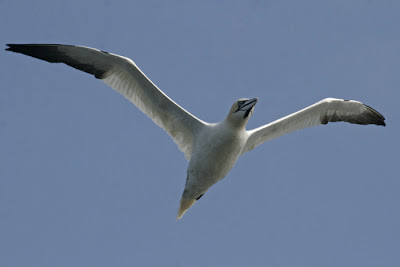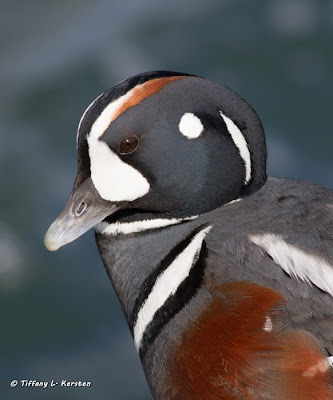Late February or early March is the perfect time to cut meadows and fields, so if you are gardening for wildlife, or simply trying to put back a little of what we have lost in Cape May, then there's still time to get the mower out and make that annual haircut. Many of our open areas in the county are being swamped by alien shrubs and grasses, but a single cut made at this time of year seems to be the best way to knock them back and to encourage native species. In my own yard, in just three years, I have converted a mish-mash of alien grasses and 'weeds' into an area dominated by native Virginia Beard-grass and Frost Aster, just by doing a single cut a year at the right time. A little bit of work has been needed to remove some persistent Multiflora Rose and Silktrees, but otherwise, it's pretty much maintenance free - which is always good news!
While doing the mowing just recently, it struck me that this is the ideal time to thin out two persistent and potentially damaging alien invaders - the Chinese Mantis (
Tenodora sinensis) and the closely-related Narrow-winged Mantis (
Tenodora angustipennis). It's a good time to thin them out because their overwintering egg cases (technically called an ootheca) are fairly obvious, attached to dried plant stems and low bushes like light brown pieces of styrofoam. As with most introduced species (deliberate or otherwise) these large, voracious insects readily cause problems in a balanced ecosystem and native fauna will not have evolved to deal with them. While we do have a native mantis over much of the eastern US, it is a smaller species and not able to take on some of the larger insects that the Asian species eat so readily.
The really big problem with these introduced mantids is that they are readily sold mail order, not only as a pet, but as so-called 'pest control'. I read a number of websites recently that made a number of remarkable, and often contradictory, claims about these beasts. While I am sure they are capable of eating some pest species (and what one person considers a pest another may not), I have little doubt that they also eat many beneficial insects - in fact I know they do because I've seen them doing it!! Claims that they eat a lot of cockroaches seems a bit far fetched, since roaches live in houses not backyards - maybe you're supposed to keep mantids in the kitchen! When at the early growing stages and thus quite small, the mantids probably do eat a certain number of aphids, but these can be controlled quite easily by maintaining a healthy, balanced garden that has plenty of habitat for birds to nest, and for natural predators such as ladybeetles.
Put simply, there is no place for non-native, highly voracious, over-sized insects in our gardens so lets all have a go at thinning them out as best we can. Now, I must admit I'm a bit of a softy when it comes to killing certain things, and mantids are pretty amazing creatures to watch and study, so it seems to me that quietly disposing of the inanimate-looking egg cases seems the best way to deal with the issue. But you need to be careful not to be removing the native species that belongs here, so below is a quick guide to identifying the egg cases. Once I have collected a handful of cases, what I usually do is push a spade into the ground to a full spade depth, wiggle a little space and drop the egg cases in. I then give the soil a good firm down afterwards. I know that some people burn them once they have collected them, but you clearly need to get a good fire going to be able to do that. I know it seems harsh, but if they weren't released in the first place, there wouldn't be a problem; maybe we need to start getting the message round more...

Chinese Mantis (Tenodera sinensis) eggcase. The cases of this species are well-round, almost globular in shape and bulge out obviously from the vegetation that they are attached to. Egg cases of all species are about an inch long or a little more [photo by Mike Crewe].
Narrow-winged Mantis (Tenodera angustipennis) eggcase. In this species, the cases are elongate and don't bulge significantly from the stem. There is also a narrow groove running down the length of the case on the underside [photo by Mike Crewe].
Narrow-winged Mantis eggcases are often found in small clusters, like this batch of three on a low twig in Cape May Point State Park [photo by Mike Crewe].
Native Carolina Mantis (Stagmomantis carolina) eggcase. In this species, the cases are again elongate and don't bulge significantly from the stem. Though the cases seem to be variable, they most often appear to be darker than the cases of the Asian species, often dark honey-colored with a paler stripe [photo courtesy of Bug Guide, www.bugguide.net].
There is a third, introduced, mantis in our area, the European Mantis (Mantis religiosa). It is currently the least common of the three introduced species in Cape May County and its eggcases are most similar to those of Carolina Mantis. Indeed, the vast majority of photos on the web are so confused that I searched for photos taken in Spain to be sure of getting it right!! The eggcase above was photographed in a field in Erma, Cape May County and is identical to Spanish specimens. It seems to differ from the native species most obviously by its overall light tan coloration [photo by Mike Crewe].
There is much misinformation about mantids on the web and, in particular, many wrongly-identified photos of eggcases (and even adult mantids) so do take a careful look at the pictures above and try to leave any native ones you may find. Of course, if you do want to keep any non-native ones you find and raise them as pets, that can be great fun, but keep them in the house, not in the garden!
Some pictures of Chinese Mantids doing what they do best - eating our native wildlife. I have photographed these insects eating many things and have not biased my findings; to date, I have only ever seen them eating species that I would not consider to be pests. In this first picture, a Silver-spotted Skipper butterfly becomes lunch...
...here, a species of robber fly...
...and here, a Monarch butterfly. Adult mantids spend much of their time waiting for a meal at flowering plants, so butterflies often constitute a high percentage of their diet [photos by Mike Crewe].
Some points to ponder:
When considering whether to buy mantises to control pests in your yard, would you listen to someone who stands to make money selling them, or someone who has taken time to study the ecology of the insects?
Mantises are good at controlling cockroaches... Really? Well perhaps only if you release the mantises into your house rather than your yard, since cockroaches are not living out in your garden.
Mantises control gypsy moth... Really? Stop and consoder how that might work? Have you ever seen mantises feeding high in woody trees - or do you typically see them waiting in ambush among your flowering plants? Also, consider what time of the year that mantises are big enough to take on gypsy moth caterpillars - it's well after the caterpillars have disappeared...
Mantises control garden pests - so how does that work? Do you give them a field guide to read? Or do you consider butterflies, honey bees and beetles to be pests?















































.jpg)
.jpg)




